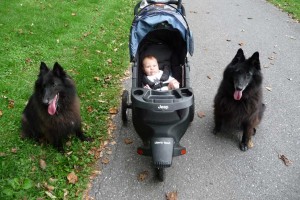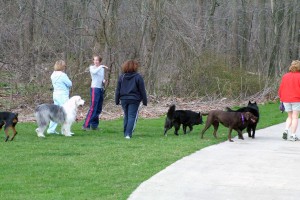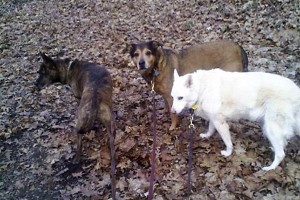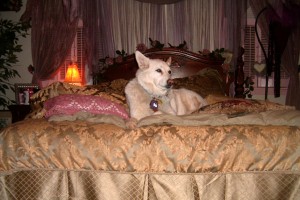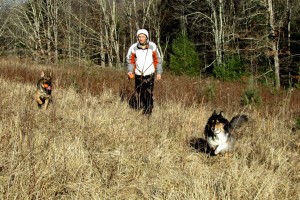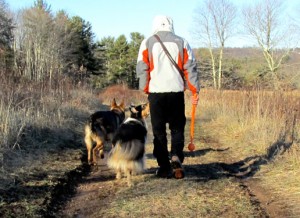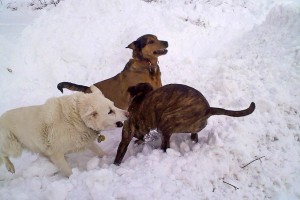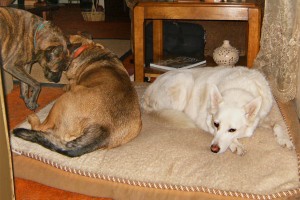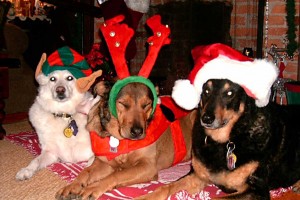This blog is probably going to upset some people I like and respect a lot, but the information that it contains needs to be more widely understood. So I will hope that while some may disagree with me, they will keep an open mind. Behavior is behavior is behavior, as I always like to say.
Strong confident breeds can successfully live together with minimal issues. It very much depends on the individual dogs in question but even more importantly, it depends on the human part of the equation. Strong parenting skills in such a household cannot be overemphasized.
This does not in any way, shape, or form involve scaring your crew into submission. Leave the dominance style training methods back in the dark ages where they belong. I very much believe in the power of positive parenting and training. Quality parenting is quality parenting, regardless of the species that you are parenting. Teaching boundaries, fairness, manners, structure and providing a reasonable regular routine as well as all of the baseline needs for each dog in your home should be your go to status quo.
A working knowledge of dog body language and specifically your own dog’s tells and body language will help you maintain a smooth baseline, as will understanding their facial expressions and verbalizations. Knowing how to use your own body language to communicate more effectively will go much further than word cues that you have taught. Dogs pay much more attention to body language than words. Humans talk a lot. Dogs, not so much!
One of the biggest mistakes that people with a multiple dog household can make is to ‘let the dogs work it out’. I cannot stress enough how much of a mistake that is. Do parents of human human children let them work it out? Not good ones! You are the parent. You make the decisions/buy the dog food/pay the bills. You are the one who is in charge of keeping shyer dogs safe from bullying and teaching pushy dogs manners. Your dogs trust you to keep them safe. You set the limits and you enforce them. YOU work it out. Interrupting behavior that has the potential to cause an issue, at the very first sign of it, should become a standard protocol.
Human children should not be permitted to be rude with siblings and the same goes with dogs who live together (or even dogs who are together regularly). Being consistent with this message goes a long way toward keeping the peace on a permanent basis. There are always going to be some dogs who are pushier than others and dogs who are shyer than others. This will happen regardless of breed. But when you have individual dogs that can have more of a tendency to have a shorter fuse, this can have terrible consequences if you don’t set and enforce boundaries about proper behavior.
I dislike labeling any dogs as potentially harder to deal with than others but some simply are as a whole, for one reason or another. Dogs from working lines of any breed, for example, are bred to have a job so there are genetics at play in many cases, even with mixes. Again, individual personality makes a huge difference but working parental traits do matter. But here is where I differ in opinion from many on some breeds. I love Pit Bulls. I have one. He lived with three other dogs until two months ago, one a confident male. Now he shares his life with just two females. My lost love was a Doberman mix male. It was a bit of a rough start at first but not because of my Pit Bull, but because Doberman males can have a tendency to be same sex aggressive. While Merlin was never what anyone would call aggressive, he was intolerant at times of repeatedly overly rude behavior from other young males. This because I fostered a lot of adolescent Doberman males. It had a cumulative effect. This could have been a problem if I had let it but I was very observant of his body language and interrupted potential issues very early on as needed. As it should be, I might add.
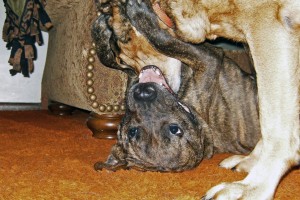
Siri and Trent roughhousing, not left on their own to work things out.
This leads up my original point about Pit Bulls. They are not the only breed that was bred to fight with other dogs nor are they the only breed that has dog aggression in the breed standard. Many breeds do. It’s in the breed standard for Dobermans that same sex aggression can be a problem. Akitas have the same issue as can Rottweilers. There are many breeds that can have this potential so I dislike when Pit Bulls are singled out for special handling because of this. The list is long for dogs that can have this issue, sadly.
I know many people have successful multiple dog households that include these breeds and often a mix of “problem breeds”. It can be done. It can also involve a lot of work for a while and sometimes it means being forever on alert. But if you are the right person for such a household, then it can be a lot of fun. Breeds that are bred to have jobs are fun to have around. They are smart and active and keep you on your toes. But they are not for everyone. That is an important distinction. And they should NOT be owned simply for a status symbol.
Not everyone wants to be that much on their toes so think hard before you decide to take on such a task. This is a commitment. You cannot slack off on the training until your household is fully established. Even then, changes in life routines can sometimes spark a spat where there previously was harmony. But don’t be too daunted: learning to be observant becomes second nature with most working dog multiple dog households. It just takes time.
Many multiple dog households such as this can safely be established to the point of safe when alone as well. But this will not always be the case. You MUST know your own dogs. That cannot be stressed enough. If there is even the hint of trouble between certain dogs ever, then until enough time has passed that you feel safe turning your back, those dogs MUST be separated when home alone. Do NOT take chances.
Any fighting of any kind is the signal to get in-home professional assistance. No one can solve such a problem from a distance. Seeing the interaction is imperative. Most spats between dogs that have not been fighting (whether verbal or physical) badly can be solved if the behavior has not become habit. Some can not. Only someone on the spot can determine that. If you need such assistance, contact us here and we will help you find someone qualified close to you.
To prevent issues, training manners and politeness is your first order of business. I do not tolerate any dogs in my home being unaware of whether they are knocking other dogs over. I will immediately get between a dog who is happily wagging her entire body while knocking over a frailer dog behind her. Rushing through doors and knocking other dogs aside doesn’t happen here either. Rude pushing to the head of the line for treats get the offending dog treated last. I will stand tall (at all of 5’!) with my hands on my hips to convey displeasure at certain behavior. It gets the point across. I call it the “mom stance”. It works without word and it’s not overly intimidating.
Mealtimes at my house are polite. Everyone has their place and no one tries to get anyone else’s food. There is no guarding of high value items and if one dog does take another dog’s chewy, it gets immediately returned by me. If there is any hint of guarding anything, the offending dog loses whatever it is, be it a couch, chewy, bone, etc. Everyone takes turns with treats, pets, cuddling, etc. If there is a problem, my dogs look to me to solve it. This is the attitude that you want your crew to have.
I have spent a lot of time training impulse control and manners and you should too, if you expect to have a smoothly running household that includes some active thinking breeds. My dogs get along so well, that they are all together when alone. I did not approach this carelessly, however. When Trent (Pit Bull) joined our household at the age of 13 months, he lived the life of a foster dog with his own room when alone, until I was very sure that all would be fine when integrating home alone time.
I would also like to emphasize that if you have such active confident breeds, every day exercise is of the utmost importance. Dogs that are bred for a job need to have activities to exercise their brains and bodies sufficiently or they will create their own activities. That can have tragic consequences.
Here are some real life scenarios that will shed some light on what it takes to do this properly:
Chris in PA has three German Shepherds: a female and an intact male and a neutered male. All three get along great, after some heavy work on her part. They eat high value foods near one another and chew high value chewies near one another. She breaks up rough play periodically to lower the excitement level. Chris expects to be training her dogs for their lifetimes. But for her it has become second nature.
Renea in Wisconsin has ten Australian Shepherds: four males, three of whom are intact and six females, two of whom are intact. Some dogs are crated when home alone and others are free. She is a professional trainer so she has spent a lot of time reinforcing proper choices by the dogs with one another. All dogs are together when the humans are home and all sleep in the same room as the humans. She controls the resources in such a way that everyone has plenty so there is no need to guard. If an issue arises, the item gets removed. Renea’s dogs get a lot of exercise in the way of various training maneuvers as well as herding.
Amy in Chicago has two Vislas, a male and a female, both altered, two Toy Manchester Terriers, both female, one altered, one about to be altered and a spayed female Doberman. All are loose together whether alone or not, after being integrated into the household. Amy also fosters rescue dogs so she takes integration slowly as needed. All new dogs are crated until trustworthy. All dogs are trained with impulse control around food. Her dogs have also been heavily socialized with day care and training trials. High value items are only out when she is around but lower value toys and chew things are out all the time. She is careful with close quarters such as doorways, which is a really important thing to be aware of with such a crew!
Denise in New York has a male and female Doberman and a male Catahoula mix as well as a visiting male Pit Bull several times a week. Her dogs have been heavily socialized so they do well with other dogs. She keeps a regular schedule which she believes helps her dogs be calmer as well as provides regular off leash exercise and playtime. She has taught her dogs that she will handle things so they look to her to direction. She also fosters and boards dogs occasionally and her dogs are welcoming to new arrivals.
Jamie in PA has two male Pit Bulls, a male Lab mix, a female Lab/Boxer mix and a female Spaniel mix. She has spent time using positive reinforcement training to teach her dogs both verbal and word cues. She is also has a background in human behavior so that helps her to reinforce good behavior within her crew while simply living life, which many people don’t understand is needed. The boys are crated when home alone and the girls are loose, though occasionally the four year old Pit Bull is loose with the girls without incident. She provides strong leadership, lots of exercise, a predictable routine and interactive toys inside and out for her crew. The boys play just fine together and all can get high value bones together in the same room without issues.
As you can see, there are commonalities among the scenarios. Leadership, routine, exercise, managing resources, careful integration, space management and impulse control training are all valuable tools. Having such a crew can be very rewarding but it comes with a commitment. Do not take it lightly but if such a household is the right one for you, do your research and go for it! You will get rewarded with a lot of love.

